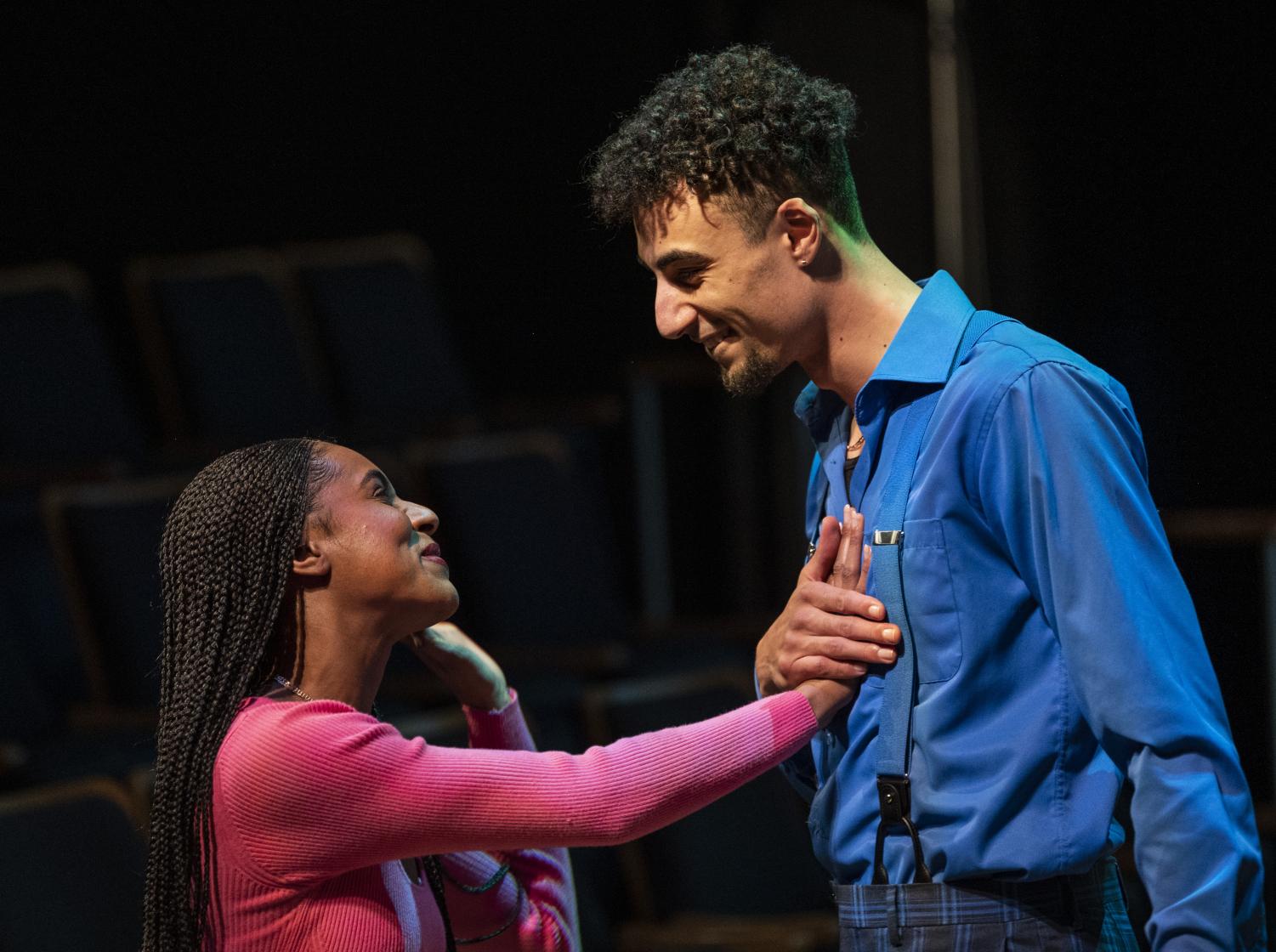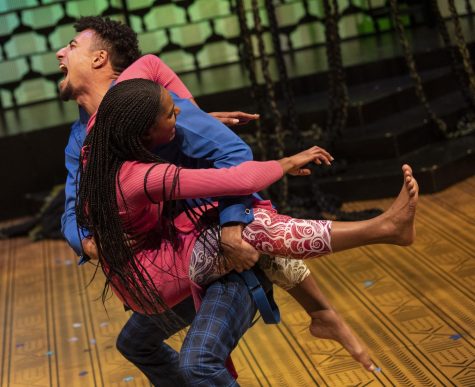PPT blends Black culture, African spiritual traditions with Shakespeare classic in ‘A Midsummer Night’s Dream In Harlem’


Brenden Peifer and Saige Smith perform during the Pittsburgh Public Theater's performance of “A Midsummer Night’s Dream In Harlem.”
The first time local performer Brenden Peifer worked with fight choreographer José Pérez IV, Peifer was a first-year at Pitt while Pérez was an MFA student. They collaborated again when Peifer scored the role of Demetrius in Pittsburgh Public Theater’s production of “A Midsummer Night’s Dream In Harlem,” directed by Justin Emeka.
“To go from doing an Intro to Performance class with [Pérez] in freshman year to doing choreography in Pittsburgh Public Theater is really cool,” Peifer said. “You just learn so much, it’s incredible.”
Centered on magic and mischief, “A Midsummer Night’s Dream In Harlem” takes place in an urban dreamscape where four young lovers face comical love triangles and romantic woes. This adaptation features an all-Black cast, whose characters challenge traditional gender and sexuality norms. The production takes place through Feb. 19 in O’Reilly Theatre.
Peifer, a 2019 Pitt graduate, has acted in past PPT productions, including “A Raisin in the Sun” and “Two Trains Running.” He said one of his favorite parts about playing Demetrius in “Midsummer” is that he has creative freedom in how he portrays the character. In the traditional version of the play, the character Helena tries to pursue Demetrius, but he feels sorry for rejecting her. Peifer said he is playing the character differently.


(Courtesy of Pittsburgh Public Theater)
“I’m playing him like he’s a player, and he is literally leading on Helena,” Peifer said. “I’m having fun with using his words to communicate one thing, but then using my actions to communicate another, but still keeping the integrity of the story going.”
The Harlem Renaissance of the 1920s and ‘30s inspired the cultural relevance of the production. Emeka said in a press release that he adapted “Midsummer” so cast members had the liberty to portray their characters in a progressive light.
“The young lovers in this production reflect the progressive ways that new generations are defining themselves by challenging gender norms and loving who they want on their own terms,” Emeka said. “Because I ultimately believe that is what Shakespeare intended those characters to do for the audiences of his time.”
Peifer said the adaption depicts elements of Black culture joyfully and without restriction, reflecting the values of the Harlem Renaissance. The time period encouraged Black Americans to view their identity with pride.
(Courtesy of Pittsburgh Public Theater)
“In the show, we pull from the Yoruba tradition. And a classic character like Puck is referred to as Puck, but also referred to as Eshu or Elegba,” Peifer said. “[He] is a God of Yoruba tradition that is so closely similar to Puck that in the cast, we’re kind of joking that Shakespeare literally might have been Yoruba because of the similarities between the two characters.”
“Midsummer” also has a fight scene between the four lovers, during which the cast performs an Afro-Brazilian martial art called capoeira. Pérez, a practitioner of the martial art, said many historians believe it originated from African people enslaved in Brazil during the transatlantic slave trade, and they disguised the martial art as a dance. Emeka is a capoeira practitioner and instructor, he said.
“It is a movement vocabulary that [Emeka] incorporated into his show. It’s not just a movement or martial arts practice,” Pérez said. “There’s deep cultural roots and practices involved, especially music, that he really ingrained into the show amidst other traditions and cultural movements that come from Harlem, that come from Black and African communities.”
Capoeira is also the national sport in Brazil, Pérez said. There are dance-like, acrobatic elements to it that were historically used for the enslaved people to practice and use in an uprising to fight for their freedom.
“I think this is the first time capoeira has ever been onstage at the Pittsburgh Public Theatre,” Pérez said. “Also, hearing some of the instruments that are involved in capoeira is really moving to me … thinking that this is the first time this space is hearing these instruments with the historical background that they represent. I think the audience will feel that as well.”
Peifer said although learning capoeira for the production was challenging, it fits well into the play.
“It’s the most fun I’ve had onstage,” Peifer said. “Incorporating [capoeira] into the play was something that I really enjoyed because of the way in which Shakespeare’s language flows … I think those two blended together well.”
Pérez said it was a pleasure to continue working with Peifer because he’s seen him develop into a skilled performer.
“It feels like a community of people — to be able to see people grow to develop your relationship with them both personally and professionally,” Pérez said. “There’s also a trust that maybe only time can develop between two people.”
Peifer added that he thinks the adaption maintains the original’s Shakespearean wit while giving the space to celebrate Black culture onstage.
“I’m really excited for audiences to see just the ways in which you can have African American culture through this world, this Harlem-is-Athens type space,” Peifer said. “It’s really a meshing of all sorts of Black cultures, and I think that’s something to be really proud of. I think we do it in a really fun and energetic and entertaining way.”
Recent Posts
Review | Delayed checkouts at ‘The White Lotus’: An unoriginal third season
(Contains Spoilers) There is no meditation class, no reiki session, no nutritionally balanced, organic food…
Celebrating Women’s History Month with the HerStory Slam Event
Idaya Sasikumar, a first-year psychology student, took to the stage to read her personal story.…
Review | Michael Franti & Spearhead reflect on the power of love in new album ‘Welcome to the Family’
Nothing says “Welcome to the family!” like a new baby. Soul-rock band Michael Franti &…
How hurling put me on ESPN and in a National Championship game
Nothing is more difficult than joining a new club in college. It is terrifying when…
Column | It’s now or never for Henry Davis
When Henry Davis came into Monday night’s game against the Washington Nationals at PNC Park,…
Pitt men’s basketball navigating transfer portal difficulties
Pitt men’s basketball is like any other team in the world of large NIL deals…
